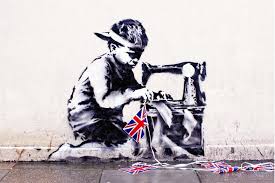First of all, let me apologise for bringing Brexit into everything. As you will see, there is a reason for this, it wasn’t just to make the title alliterate (though that was part of it).
The recorded history of slavery in the British Isles begins in Roman times, though it probably existed long before then. According to Tacitus, Calgacus, leader of Caledonia, warned that the punishment for defeat by the invading Romans would be slavery. Britannia Prima, the Roman province roughly corresponding to Alfred’s Wessex, was a mining district, as we have seen, so it is likely that slaves would be sentenced to a life of hard labour in the mines.
Slavery continued long after the Romans departed. Saint Patrick, who may have been born in the Romano-British settlement of Portus Abonae (modern-day Sea Mills in Bristol), was sold as a slave to the Irish, part of a thriving trade between the two lands. King Ine’s law code later decreed that any Wessaxon selling another Wessaxon into slavery was to pay a wergild as a penalty.
Nevertheless, the Domesday book records that at the time of its compilation, some 10% of the population of England were slaves. Perhaps surprisingly, given the overall negative effects of the conquest on English freedom, outright slavery declined over the following century, and was non-existent by 1200. However, English people living in the Welsh marches were subject to border raids by the Welsh, who continued to press captives into forced labour.
From the 17th Century, penal transportation led to a new kind of slavery, with people being shipped off to new colonies in the Americas and Oceania as slaves or indentured servants, often for relatively trivial offences such as vagrancy (which, among other injustices, led to many Romanies being enslaved merely for pursuing their traditional nomadic way of life). In Wessex, the main destination for bondsmen was the area around Chesapeake Bay, in service to disaffected Cavaliers. The area is a shallow estuary with a humid subtropical climate, making it attractive to mosquitoes, and so many of these indentured servants ended up dying of malaria.
Bristol was, of course, a hub for the notorious transatlantic slave trade. Many places around the city are, controversially, named after slave trader Edward Colston, and there is a statue of him in the city centre. Concert venue the Colston Hall, which had been boycotted by artists such as Massive Attack in protest, announced that it would be changing its name in 2020, though the new name has yet to be announced at the time of writing.
Slavery was officially abolished in 1807, though it was not until 1838 that all slaves in the British empire were finally emancipated. The Bishop of Exeter was among those slaveholders compensated by the British government for the loss of their “property”. The Royal Navy became active in enforcing abolition, aggressively pursuing West African slave ships and Barbary pirates.
I wish I could say that was the end of the story. But sadly, human traffic continues well into our own century. According to the charity Anti-Slavery International, the government estimates that there are tens of thousands of people living in slavery in the UK today. Moreover, the same charity warns that Brexit has the potential to weaken existing protections against slavery if it results in withdrawal from Europe-wide criminal justice initiatives such as Europol and the European Arrest Warrant. It is sincerely to be hoped that decades of progress in this area are not undone by the Law of Unintended Consequences.

